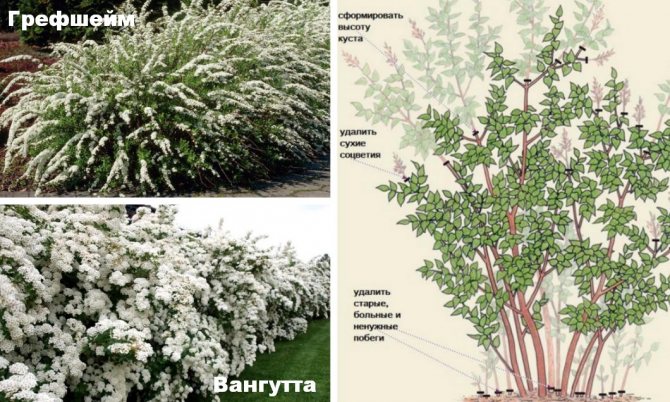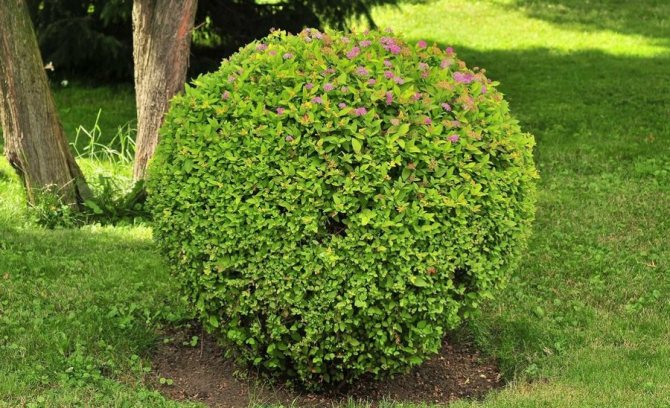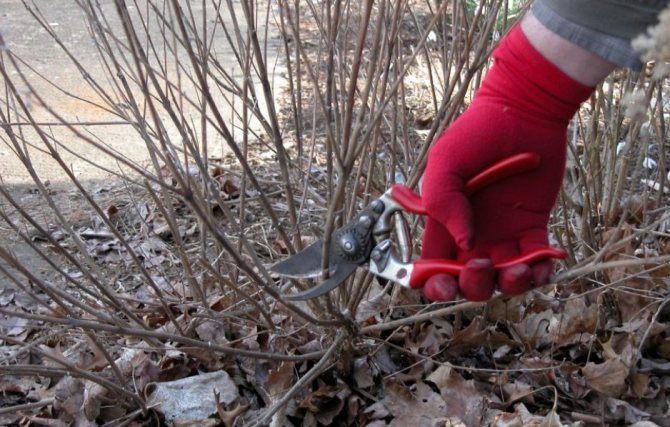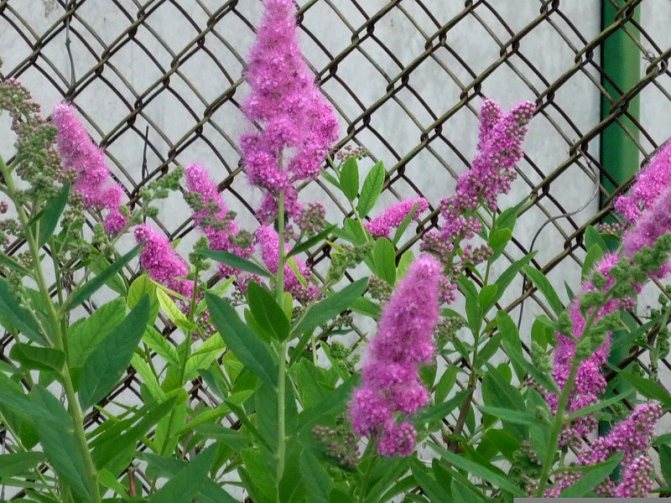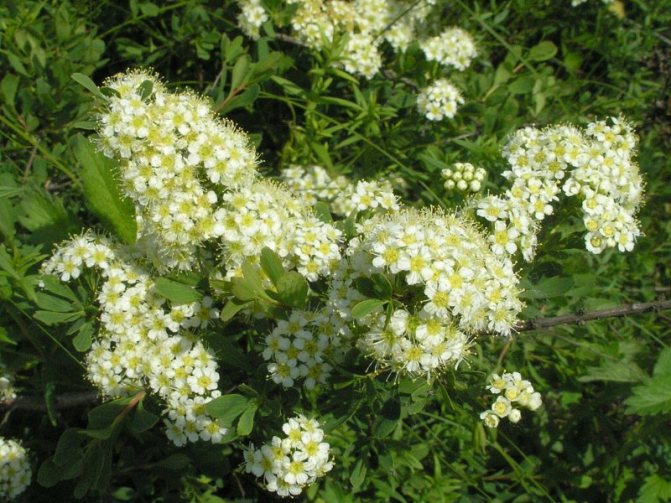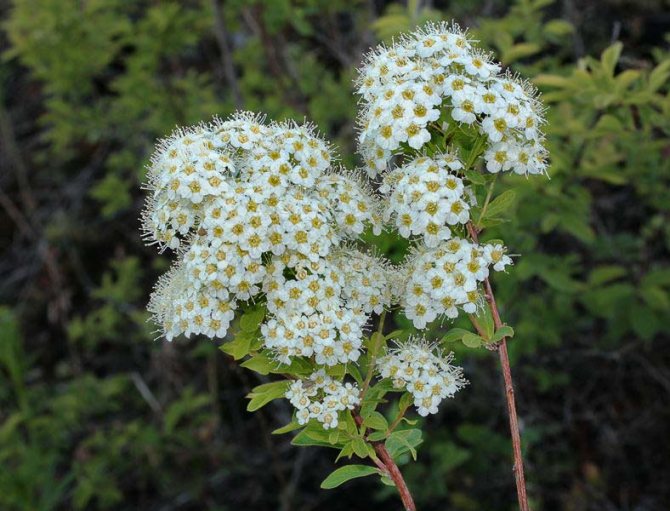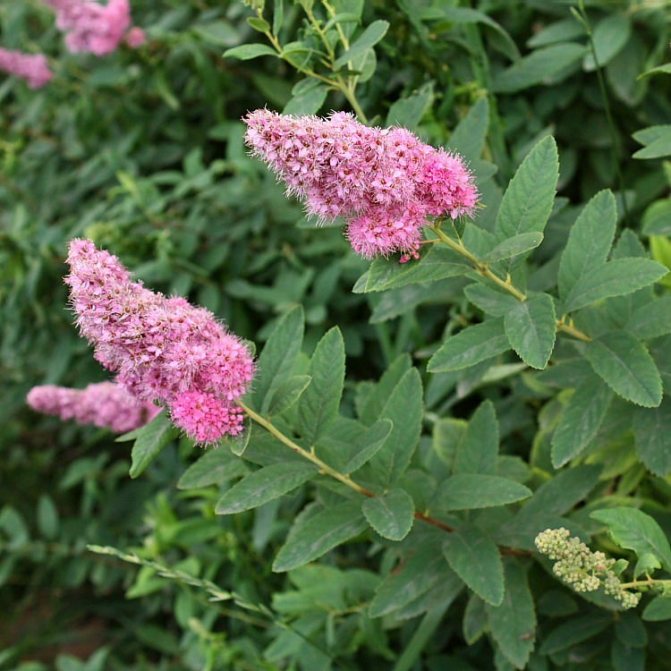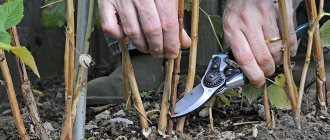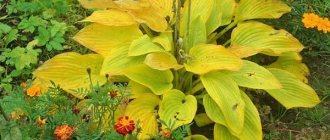The spreading and lush-flowering shrub of spirea enjoys special attention of gardeners. This decorative culture is unpretentious to growing conditions, however, it requires special care during preparation for wintering. Today we will tell you whether you need to cover the spirea for the winter.
- 1 Pruning plants in autumn 1.1 Video: "Autumn pruning of Japanese spirea"
- 1.2 Blooming summer
- 1.3 Blooming in spring
The benefits of pruning spirea in the fall
Spireas look great during flowering! In the photo in the article, you will see various types of this ornamental shrub. The plant has its advantages:
- unpretentious care;
- the possibility of disembarkation anywhere in the garden or yard;
- does not require special lighting;
- grows on any soil;
- not afraid of cold and winds;
- long flowering (up to 100 days per season).
Both lonely bushes and hedges should be pruned. Such care for the spirea in the fall stimulates flowering. It promotes the growth and development of shrubs. Pruning spirea in the fall gives the bushes the desired shape and appearance, for every taste.
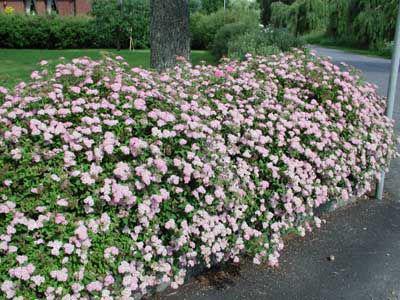
Decorative spirea
There are many types of spirea, and each variety is beautiful in its own way. However, in our gardens they usually grow:
- spirea Wangutta;
- oak-leaved spirea;
- spirea Thunberg;
- gray spirea;
- spirea willow;
- Japanese spirea;
- white-flowered spirea.
All of these varieties are about the same in care, and are cast only by the fact that some of them bloom in the spring, and some in the summer. If you combine varieties in a hedge depending on the flowering time, then you can achieve its decorative effect throughout the season.
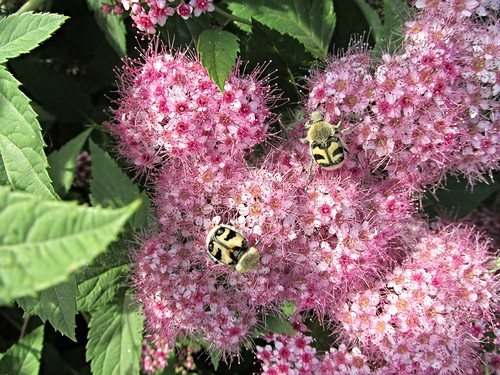

This is exactly what I do - I combine different varieties in my hedge, as a result of which my spireas bloom from mid-May to almost autumn.
Features of early flowering spirea
The inflorescences of spirea, blooming in spring, have a white color and are formed on last year's shoots. From early flowering varieties, sharp-toothed, oak-leaved, nippon spirea can be distinguished. Many gardeners know the Vagutta variety. It blooms in May and blooms until mid-June. Pruning spirea in the fall consists in removing weak shoots and forming a frame of strong and healthy branches.
This ornamental plant shrubs very well and grows quickly. For a neat decorative effect, spirea is pruned annually in the fall. To do this, 1/5 of all shoots of the bush are cut out to the very soil. A bush thinned in this way will give more powerful young shoots next year.
Inflorescences that have faded are removed after wilting or at the beginning of autumn, leaving only young shoots. Every 2 years, the bushes are thinned out, crooked, thin, weak branches are cut. Once every 8 years, the spirea is cut thoroughly in the fall, leaving only young branches.
What are the features of preparing for winter in different regions
The climate of different regions of Russia is very different from each other, therefore, in order for the wintering to end successfully during the preparatory work, it is necessary to take into account the weather conditions.
In the Central lane and the Moscow region
If it is a snowy winter, the upper part of an adult shrub is not covered, since the snow cover will protect the branches of the spirea from unexpected severe frosts. To protect the root system, the spirea's near-stem circle is covered with a 10 cm layer of mulch, which is applied with tops or branches.
In the Volga region
The plant is insulated in the same way as in the Middle Lane. The only thing I would like to remind you about is the need to carefully cover young seedlings, regardless of the growing region.
In the Urals and Siberia
In the northern regions, only winter-hardy varieties are grown that are capable of reinsurance during six months of cold weather. Pruning in the Urals and Siberia is carried out in the spring, since the large-scale removal of branches can take a lot of strength from the plant, and it will not be able to survive the winter. Shrubs are covered in the same way as in other regions. The only difference is that the thickness of the mulch layer increases to 20 cm.
Pruning varieties that bloom in summer
Several varieties of spirea have been bred, which bloom in the summer months. Such bushes have bright lush inflorescences of pink, purple or soft coral. Of late-flowering varieties, Japanese, willow, birch-leaved spirea can be distinguished. This group also includes the Billiard, Douglas, Bumald varieties.
In the first year of planting, the bushes are not cut off at all. The next year, pruning spirea in the fall is carried out slightly, only weak shoots are removed. They also form a bush by removing faded parts of the branches. Cut off shoots in spring begin to branch out, and an abundant crown is formed. Light penetrates better to a thinned plant, it is well ventilated. Sanitary cutting of shrubs prevents the occurrence of fungi, various infections and the appearance of pests.
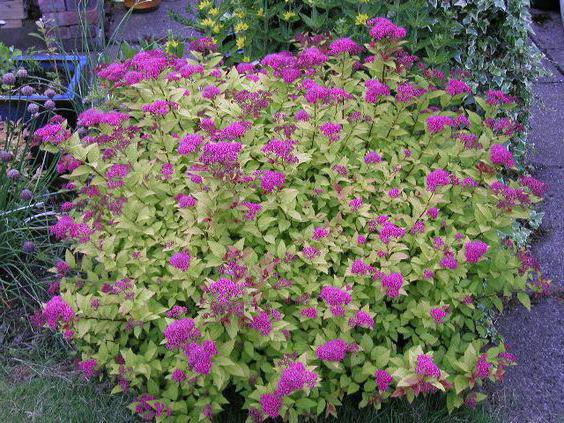

Spring flowering varieties
Spireas, which bloom in spring, usually have white inflorescences and look, I would say, "fluffy". During flowering, the bushes are literally covered with flowers so that no greenery is visible. Such spireas decorate the site simply unusually.
Spirea Wangutta can be either tall or medium in size. Both varieties will work for hedges, but lower bushes are easier to care for. This variety blooms very profusely and for a long time, until the end of June.
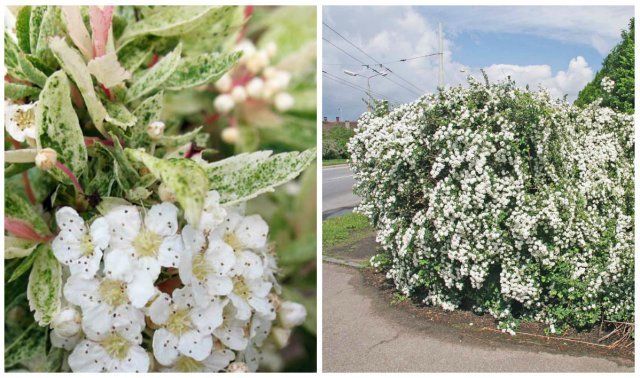

The oak-leaved spirea looks wonderful, which begins to bloom in early May. It blooms very first, and grows rapidly. By the way, this spirea perfectly tolerates any haircut, so it is often used for hedges.
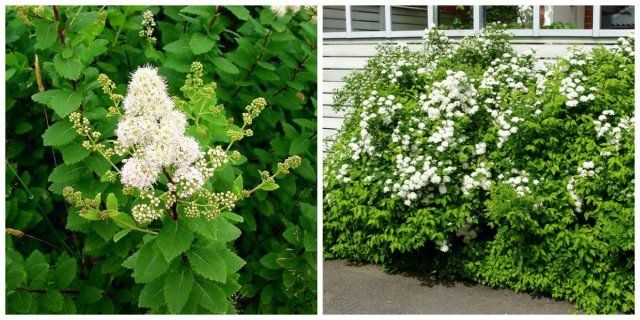

Spirea Thunberg is the most common variety, without which no garden can do. It grows up to one and a half meters, has a "loose" appearance, while its foliage changes color depending on the season, from bright green to orange, which makes the spirea even more decorative.
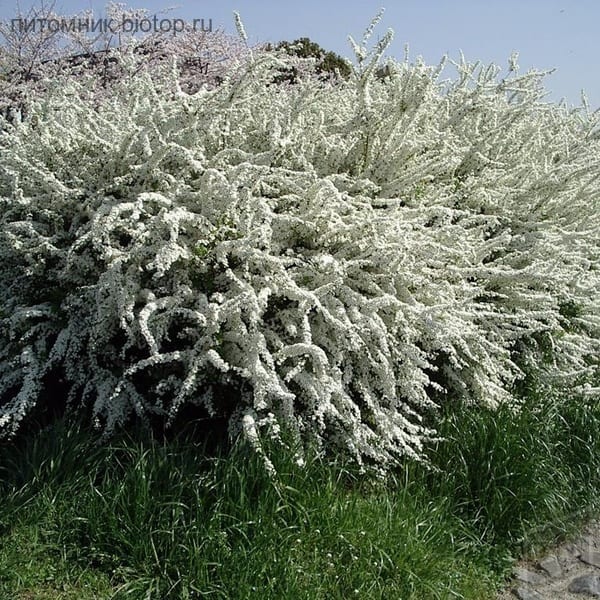

One of my favorites is the gray spirea. It blooms around the beginning of June, sometimes a little earlier, and reaches a height of more than two meters. She has only one drawback - I am sorry to cut her off, she looks too beautiful during flowering. It's just that the hand does not rise to cut these long flexible lashes. We have to remind ourselves that it is pruning that contributes to the growth of a denser green mass and, as a result, prolonged and decorative flowering.
However, spiraea tolerates pruning in the fall well, and the next year the branches grow again.
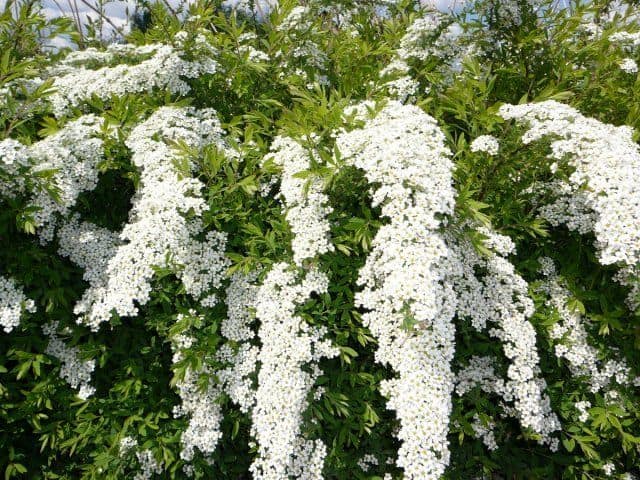

Haircut to stimulate flowering
To make the spirea bloom better, cut the shoots at the very tips. To do this, it is enough to remove a third of the length of the flowering part of the branch. This pruning stimulates the formation of side shoots and abundant flowering.
Once every 4 years, it is useful to renew the shrub by cutting off branches at a height of 30 cm from the ground. This pruning can be done in spring or fall. It is important to do it 2 weeks before the onset of frosty weather, so that the plant has time to recover.In the spring, such a pruned bush will begin to actively renew itself: lateral shoots will go from each branch, which will bloom profusely in July.
Features of the care and preparation of spirea for frost
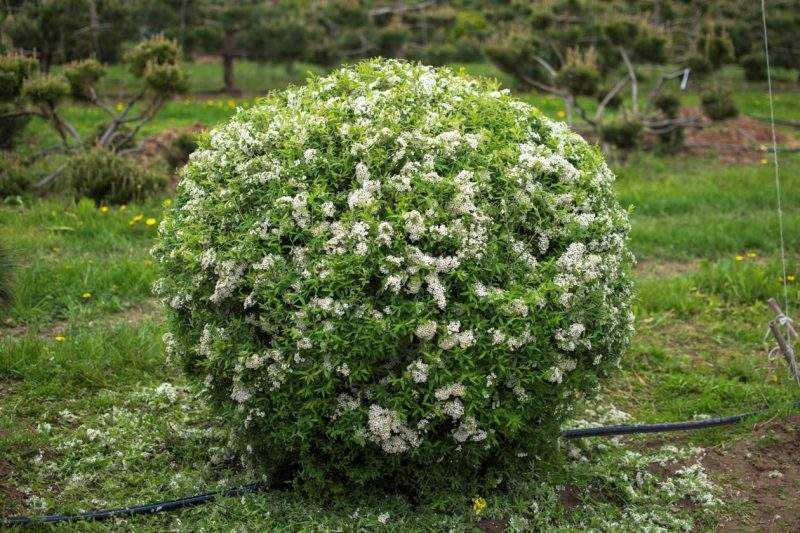

In order not to harm the shrub with improper care in the fall, when determining the need for certain work (watering, pruning and shelter), take into account the degree of resistance of a certain variety to low temperatures and the growing region. Most varieties of meadowsweet tolerate frosts from 35 to 50 degrees; in areas with a mild climate, they can not be sheltered. For colder areas as well as thermophilic varieties, protection is a must. Features of spirea care in different regions:
- Middle lane, Moscow region - if snowy winters have been observed for several years in a row, it is not necessary to cover the branches of an adult bush, just shovel snow to the meadowsweet. And the roots will have enough mulch, covered with branches or spruce branches.
- Volga region - the bush is protected as in the previous case.
- Urals and Siberia - in cold regions, the most frost-resistant varieties are planted, adapted to a long cold period. Winter shelter is a mandatory procedure. The bushes are sheared before bud break, as significant autumn pruning will weaken the spirea before wintering.
Attention! If you planted a plant in the fall, be sure to cover it up for the winter, even if your area has warm and snowy winters.
After leaf fall, if the autumn was dry, pour about 15 liters of water under the bush, loosen the ground, in the case when the season was rainy, there is no need for moisture. To protect the shallow root system, cover the root circle with a 1: 1 mixture of leaves and peat or straw. In areas with severe, snowless winters, it is better to organize an air-dry shelter. Before starting a haircut, carefully inspect the bush, if there is a cobweb on the branches, remove it. Treat the meadowsweet with a spider mite drug. Typical mistakes of autumn spirea care:
- do not water the bush before starting the shelter, the roots rot from excess moisture, the meadowsweet dies;
- do not apply nitrogen-containing fertilizers;
- do not neglect the recommendations regarding the timing of pruning, if the procedure is carried out too late, the bush will not have time to recover and gain strength before the onset of severe frosts;
- do not throw plant residues near the bush, burn them away from the garden.
You may be interested in:
The harvest is harvested: we cut the currants correctly In this article, we will talk about why you need to properly prune currants after harvest. It is also important to know exactly ... Read more ...
Having spent a minimum of time and effort on autumn care, next season you will enjoy the bright and abundant flowering of a lush, healthy bush. Failure to comply with these simple recommendations and insufficient study of the technology of growing shrubs as a whole can negatively affect its further development. A bush that is fast-growing by nature can weakly build up green mass, lose immunity to diseases and pests.
Pruning for rejuvenation
The life span of some types of spirea is 20-25 years. One stem lives for 6-7 years. The old bush sometimes loses its attractiveness, is affected by pests, so it is betrayed by deep pruning. Such a shrub is completely cut to the ground. In the spring, dormant buds will begin to sprout near the root collar. Thus, the spirea will completely rejuvenate.
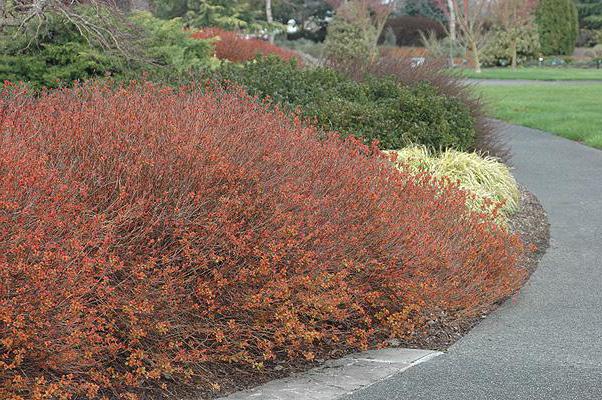

Reviews and comments
I like the spirea because it lends itself easily and tolerates a haircut without any problems, you can mold it as you wish, and it is very simple to care for the bush. I planted species that bloom at different times in turn, so I have a fence, smart from spring to late summer.In recent years, she began to notice that with aging, Japanese spirea bushes recover worse after low pruning, they have a tendency to bare the root collar.
Practically everywhere there are recommendations regarding the removal of inflorescences as they wilt. I do not do this, they do not spoil the appearance, so why not postpone the procedure for the main pruning season - autumn. I live in the Moscow region, I don’t cover the branches of the spirea with Gray, I only mulch the ground and add snow, my friends from Crimea don’t protect the shrubs at all, their thermophilic varieties overwinter without consequences.
How to cut a hedge
Spirea is great for hedges. Spirea care in autumn is preferable to spring. Such a haircut before wintering prepares the plant for the cold weather and saves the gardener's precious time in the spring. October and September are the best times to model hedges. Such a haircut contributes not only to natural air circulation, but also to the attractive appearance of the bushes, their compactness and density.
Already in the second year after planting, the young hedge needs to be cut. To do this, cut off a third of the branches from the annual growth. After four years, the branches are cut in half. In order for the hedge to serve for a long time, the bushes are fertilized, watered and mulched.
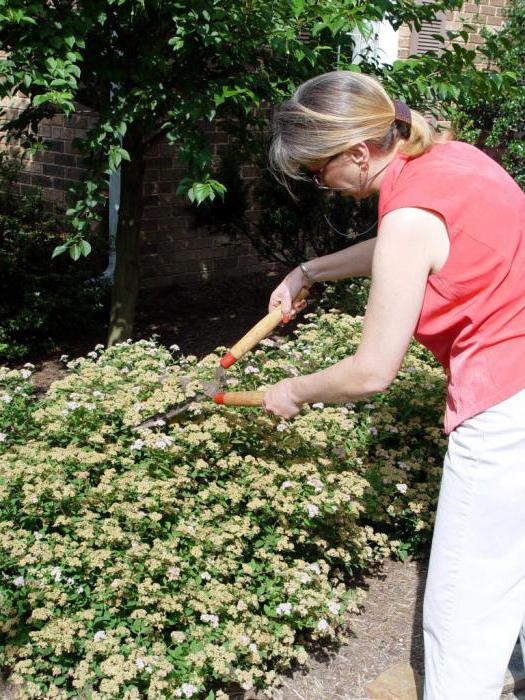

When and how to cover spirea for the winter
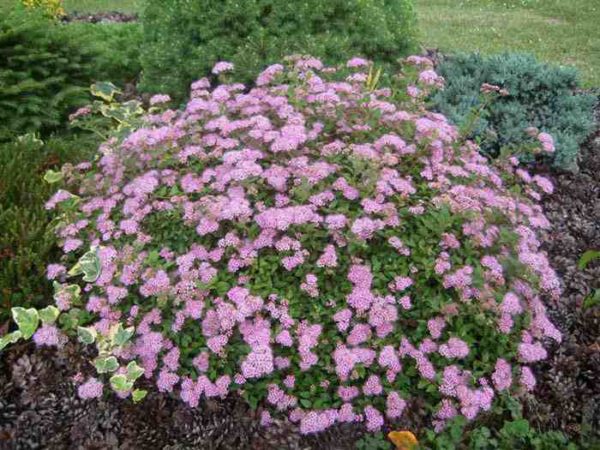

It is quite simple to protect meadowsweet from frost, while no expensive, special materials are required. In the conditions of mild and snowy winters, a layer of mulch up to 15 cm is laid. Where winters are severe and snowless, the layer is increased to 25 cm and the meadowsweet is wrapped. Be sure to protect the branches of young and weakened shrubs, immunity to low temperatures in a plant manifests itself at 4 years of age. How to make sure that the covered bush does not come out:
- collect the shoots in a loose bunch, tie it with a rope or fix it with twine;
- cover the trunk circle with mulch;
- gently bend the connected branches to the ground and secure them in any convenient way;
- lay dry leaves on the stems (layer 10–30 cm) so that the wind does not carry the mulch, press it down with dry branches.
In winter, throw snow on top of the shelter, if possible. The stems can not be bent to the ground, but the bundle can be wrapped in any heat-insulating material. An air-dry shelter for wintering spirea in harsh conditions consists in organizing an impromptu greenhouse. Install the frame over the bent shoots, cover it on all sides with any waterproof material that retains heat.
Spirea care in the fall includes a number of mandatory, but very simple activities that cannot be ignored. The shrub is able to recover quickly, but if you cut it incorrectly or improperly shelter for the winter, you will most likely have to wait for a lush flowering until next year, is it really worth the risk! Be sure to study the characteristics of the varieties planted, then it will be easier for you to draw up a work plan for the fall.
Basic rules and scheme for autumn pruning
Novice growers do not know whether to trim spirea in the fall. Here they will find the exact answer to this question. Autumn spirea haircut begins after the plant has stopped blooming. It is important that the slices are delayed until the first frost. Some gardeners carry out this procedure at the end of September. Pruning bushes in the first year of planting is only preventive in nature: only dried and diseased branches are removed, allowing the plant to develop independently.
Decorative and rejuvenating pruning is carried out at least after a year, so as not to damage the flower buds. Too pruned spirea will not bloom so profusely.
Experienced gardeners take into account the plant variety and flowering time before cutting. Early flowering species of spirea are pruned at the end of summer. This will promote abundant flowering next year. We provide a list of general rules to follow when pruning all varieties of shrub.So, the scheme for trimming the spirea in the fall looks like this:
- The first pruning is carried out two years after planting.
- The lifespan of the branches is about 5 years, so the shearing is done to ensure the beautiful appearance of the bushes.
- Every seven years, the plants are pruned to a stump. Thus, a new bush is formed from young shoots.
- The best effect is obtained when pruning the spirea in early autumn, as soon as the plant has bloomed.
- To increase the density of the bush and reduce its size, old shoots are simply shortened.
- In order to prevent diseases, old branches and affected shoots are removed.
It will take several years to form a beautiful ornamental bush. 2 years after planting, 5-6 of the strongest young branches are selected. All others are cut off completely. After the first flowering, only weak branches are cut. Every 2-3 years old shoots are removed, and only young ones are left. Thus, they form the basis of the future shrub.
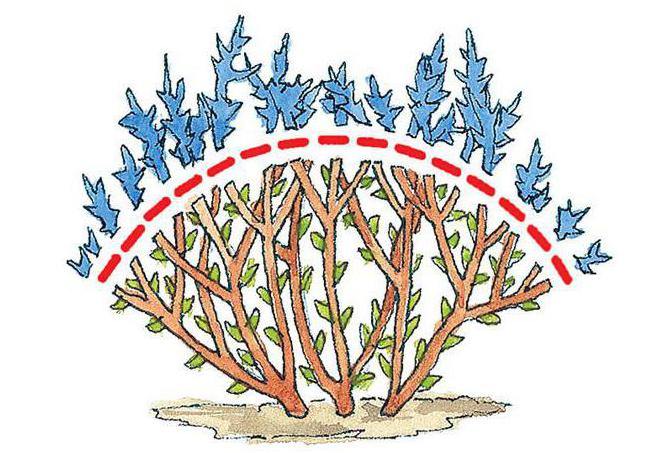

Shelter nuances in different areas
The territory of the Russian Federation covers several climatic zones. Accordingly, the features of autumn care and shelter of plants for the winter should be different. For example, spirea shrubs growing in the south of the country do not cover at all. In order for an ornamental culture to successfully winter, you need to mulch the trunk circle and the base of the bush.
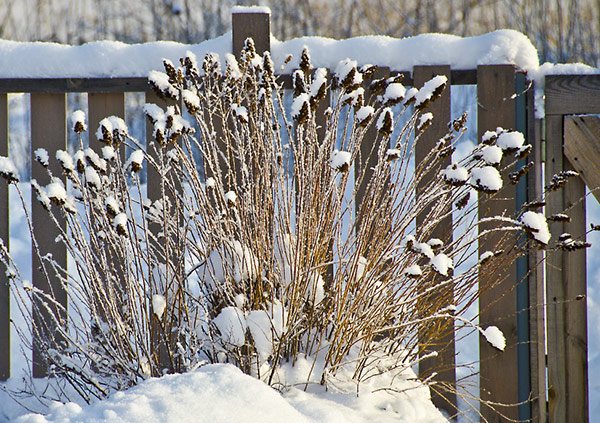

The middle zone of Russia, the Leningrad region and the Volga region are distinguished by sharp temperature drops. If the winter is snowy, you do not need to cover the spirea. Winters with little snow and unstable require more careful maintenance of the plants in the garden. The crown is covered with any non-woven fabric or pine spruce branches.
In Siberia and the Urals, only frost-resistant varieties of Billard, Douglas, gray, crenate, medium, willow and birch-leaved spireas are grown. The mulching layer is increased to 20–25 cm, the bush itself is covered with a “non-woven cloth”, opal foliage and pine branches.
In order not to injure the ornamental bush on the eve of the winter cold snap, it is recommended to abandon the autumn pruning.
Transplant pruning
Autumn is a time not only for pruning, but also for planting shrubs. How is spirea transplant carried out in the fall? At this time of the year, early flowering and late flowering spirea are planted. Most often, the method of dividing the bush is used for this. For such a planting, it is not necessary to wait for the end of the leaf fall. You can divide 3-4-year-old plants. The bush is dug out, capturing half of the crown projection. The excess roots are cut off, the rest are washed out. In some cases, the dug plant is placed in a bucket of water and the soil is allowed to oxidize. Then this bush is divided into 2-3 parts with pruning shears, the branches are shortened by a third.
Then the transplantation process begins: they dig a hole and make a drainage layer. Broken brick or granite is used as drainage. Add some peat on top. The planting hole should correspond to the size of the seedling roots. The root system should not rest against the edges or the bottom of the pit, it needs space. Transplanting spirea in the fall requires the addition of sand and sod land to the soil. The plant is lowered into the hole so that the root collar is located at ground level. The land around the divided bush is thoroughly crushed and watered. It should be noted that the spirea perfectly tolerates the autumn transplant, which is combined with pruning.
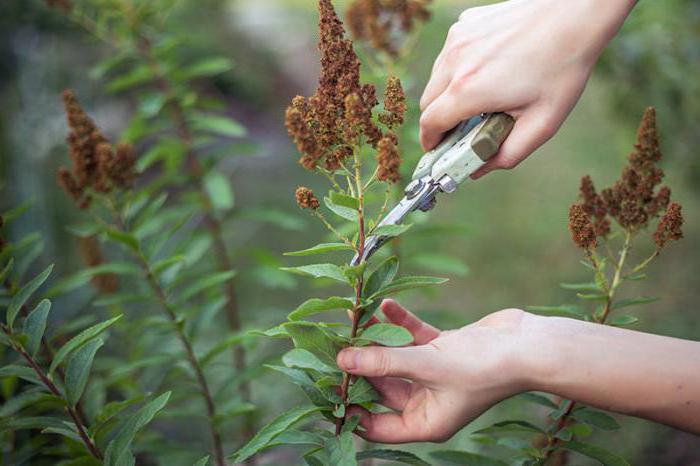

How to properly plant spirea in the fall
This ornamental shrub looks great both individually and in group planting. For example, it is often used as a hedge. Before planting, you need to choose a suitable place, and also stock up on a sufficient amount of planting material.
Landing site preparation
A planted spirea will do well in an open, well-lit area with loose soil.It should be borne in mind that partial shade has a good effect on this plant, it feels better in such conditions and gives brighter flowers, but their number will be less than when grown in open areas.
Sand or peat is often added to loosen the soil. These plants do not tolerate excess moisture, therefore swampy areas of the terrain are not suitable for planting them. Conifers get along best as neighbors with spirea.
Preparation of planting material
As a rule, the seedlings of this shrub are sold in nurseries or specialty stores. Their root system must be closed, that is, the seedling must have a clod of earth on the roots. It is preferable that it is young and does not have leaves, since their presence negatively affects the survival rate of the plant. If the root system of the seedling is open, it must be examined. The roots should be moist, pliable, and free from blackness. It is encouraged if they are covered with a mixture of manure and clay. The bark of the seedlings should be green and the buds alive and well.
Rules for planting spirea in the fall in open ground
In the fall, it is allowed to plant a spirea of both spring and summer flowering periods. It is better to do this in wet rainy weather, so the plants take root better. The planting hole needs to be prepared a few days before planting. Its size should exceed the volume of the root system together with a lump of earth. The pit walls are made vertical. A drainage layer of broken brick, expanded clay or crushed stone must be laid on the bottom.
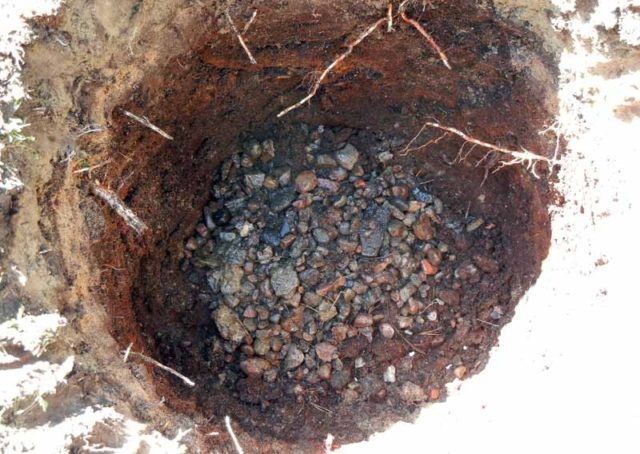

Then an earthen mound is poured in the center of the pit. A seedling is installed on it. If the root system is open, the roots of the seedling are spread along the walls of the earthen mound, and then sprinkled with soil up to half. After that, a bucket of water is added to the pit and finally fall asleep. The soil is slightly compacted, an earthen bead is poured around the seedling to prevent water from spreading during irrigation. After that, the root zone is mulched with peat or humus.
How to transplant spirea to a new place
Spirea that has not reached 4 years of age can be safely transplanted to another place in the fall. The easiest way to do this is by digging it up along with a clod of earth on the roots, and then planting it in another place. The root system of older bushes is already quite well developed, so transplanting an adult spirea in the fall will be fraught with certain difficulties. In this case, often not the entire bush is transplanted, but only part of it.
When is it better to cut spirea - in spring or autumn
Spiraea is popularly called a bride. In order for such a sign to correspond to reality, it is important to form the bushes correctly and in the right time. Many flower growers and professional designers love the plant for its abundant and long flowering, airiness and tenderness that it brings to the urban and garden landscape.
You have already traced what to do with spirea in the fall. Is it possible to cut it in the spring? Undoubtedly! In April, summer-flowering varieties of this ornamental plant are cut off. To form a beautiful bush in the spring, do the following steps:
- In the first year after planting, the shoots are shortened by half. The branches are cut to the bud, which is directed outward.
- After flowering, the inflorescences are cut off, thus stimulating the growth of lateral shoots. The plant blooms continuously.
- In the second year, again in April, the shoots are cut to half the length, and in the summer, wilted inflorescences are removed.
- In the third year, they do the same procedure, only in the spring they also remove old shoots to the ground.
The ancient Greeks admired the grace and refinement of the thin curving branches of the spirea. Breeders have bred many types of their favorite decorative culture. Among them are weeping, hemispherical, pyramidal, creeping, dwarf spireas. Most of them tolerate winter frosts well. In severe winters, some species may freeze slightly, then these branches are pruned in the spring.For varieties that are very afraid of frost, the tops of the branches are tied into a bunch, bent to the ground and covered with dry leaves. Take care of this unpretentious plant in spring and autumn, and it will delight you with delicate flower clouds.
How to prepare spirea for winter
The winter hardiness of this plant is sufficient to calmly endure frosts down to -50 ° C. Excessive watering in the pre-winter period, pruning too late, due to which the plant does not have time to recover, as well as fertilizing the spirea in autumn with nitrogen mixtures, which stimulates the growth of shoots, thereby depleting the vitality of the bush, can weaken the frost resistance. If you do not make these mistakes, it is quite simple to prepare the spirea for wintering.
Do I need to cover the spirea for the winter
In regions with a large thickness of snow cover, no additional shelter for the spirea is required for the winter. If the thickness of the snow cover is insufficient, the bushes are covered with a layer of mulch, as well as sawdust, fallen leaves, straw, tops and other plant residues.
Preparing spirea for winter in the suburbs
In the Moscow region and throughout the central part of Russia, a fairly large amount of snow falls in winter. In these regions, in the pre-winter period, spirea bushes are tied in a bunch and laid on the ground. Additionally, the plants are covered with a layer of fallen leaves on top, and then with snow. Such protection is quite enough for the plants to overwinter painlessly.
Preparing spirea for winter in the Urals
The climate of the Urals is more severe than that of the Moscow region. Preparing the spirea for winter is done in the same way, however, it is more advisable to increase the heat-insulating layer. If in the Moscow region the thickness of the mulch layer of 10 cm is guaranteed to protect the spirea bushes from freezing, then in the Urals it is necessary to increase it at least twice.
Care after pruning
After pruning, the shrub is watered abundantly and fertilized. Then the soil is covered with peat or compost. In summer meadowsweet can be supported with an organic mixture with minerals. To do this, the mullein is diluted with water in a ratio of 1: 5. Add 10 g of superphosphate, diluted with 1 liter of boiling water and stand for a day.
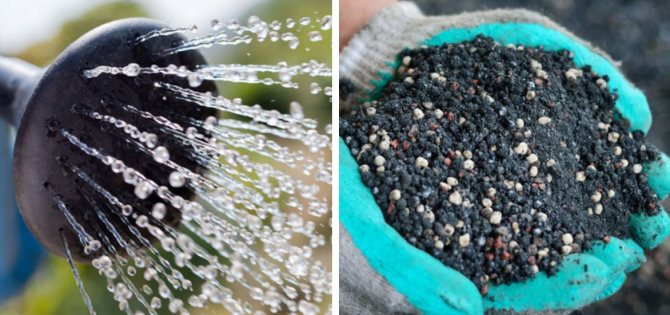

Such dressing is applied at the rate of 10 liters per bush. In order for the fertilizer to be well absorbed, the perennial is watered the day before. Some time after feeding, the bush is again watered and mulched. Sawdust, foliage and compost can be used as mulch.
Did you know? Human life depends on 1,500 varieties of cultivated plants. Moreover, about 90% of plant food is obtained from plants.
Pruning spirea gives rise to the active growth of new shoots. This little concern will ennoble any area, even with minimal maintenance.
Formative pruning of spirea. Pruning summer blooming spirits
are gradually winning places in our hearts and in suburban areas. Given their huge variety, these undemanding plants can be used to decorate any garden so that flowering will continue all summer.
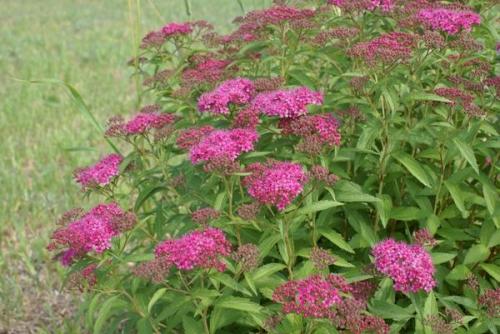

Spirey Bumald. Photo by the author The group of summer flowering includes spireas, the inflorescences of which end the shoots of the current year. Here are their main types:
- Japanese spirea (‘Little Princess’, ‘Genpei (‘ Shirobana ’)’, ‘Golden Princess’, ‘Macrophylla’, ‘Goldflame’, ‘Golden Carpet’ and others);
- spirea Bumald - a hybrid between Japanese spirea and white-flowered spirea (‘Anthony Waterer’, ‘Crispa’, ‘Dart’s Ded’ and others);
- birch spirea;
- Billard's spirea - a hybrid between Douglas spirea and willow spirea;
- spirea Douglas;
- spirea willow;
- white-flowered spirea;
- spirea felt.
Knowing the basic rules of pruning, it is not at all difficult to get harmonious plants on your site that bloom profusely until the very cold. You need to prune these types of spirits in early spring. You can start working with them immediately after the snow melts. First of all, remove old shoots that have strongly deviated to the ground, drying out, as well as damaged and frozen branches. Then the bush must be cleaned of thin thickening twigs.Small nondescript inflorescences are subsequently formed on them, while the plant spends part of its energy on them. The remaining healthy strong shoots are cut at a height of 20-25 cm.
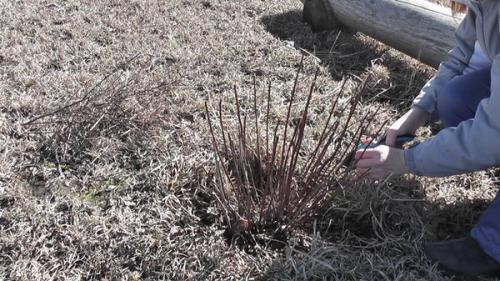

Trimming the spirea. Photo by the author These are general guidelines for all spireas blooming in summer. There are also nuances that take into account the peculiarities of the development of different species.
- Spireas of Douglas and Boomald are first pruned in the fourth year of life.
- Miniature spireas, such as ‘Golden Carpet’, ‘Magic Carpet’, ‘Candlelight’, in which the height of an adult plant does not exceed 30-40 cm, are cut into 2-3 healthy buds. The length of the shoots left may be 10-15 cm.
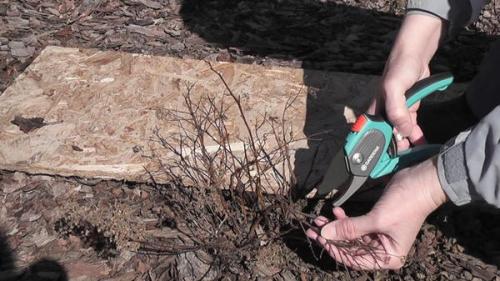

Trimming a miniature spirea. Photo by the author
- In varieties of spirea Bumald, splitting of signs is often manifested at 4-6 years of age, which can be seen by the appearance of shoots with variegated foliage or completely white leaves. This does not mean that the bush is sick, but such shoots should be cut.
- Golden-leaved varieties of Japanese spirea often release shoots with leaves of bright green color, which stand out strongly against the background of yellow foliage. Such shoots, as in the case of the white-leaved in the Boomald spirea, should be cut out. However, it also happens that the appearance of one green branch in a birch-leaved spirea-gold gives a special charm to the plant. Here you have to act as your soul tells you.
You can choose summer-flowering spireas for your site in our market, which unites large online stores. Selection After the first wave of flowering has passed, seeds begin to form. If you do not plan to seed reproduction, then it is advisable to cut off the drying inflorescences at this time. This will provoke the regrowth of new shoots and after 10-14 days the bush will again be covered with flowers.
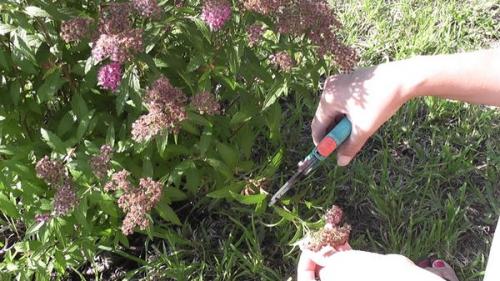

Spirea bumald. Pruning dried inflorescences. Photo by the author With a small number of bushes that need pruning, attention is paid to each shoot. If you are a happy owner of spire, then you can carry out massive formative pruning - most species of this shrub respond well to it. For the harmonious development of plants and abundant re-flowering immediately after pruning the spirea, it is advisable to feed it with mullein infusion or complex. In the next video you will see pruning of several varieties of summer-flowering spiraea. These wonderful shrubs are distinguished by excellent winter hardiness and unpretentiousness, practically do not get sick. However, spring pruning for them is a vital event that cannot be neglected.
Varieties of spirea
The genus Spiraea belongs to the Pink family, and includes over 80 species of ornamental deciduous shrubs. The average height of the culture is 90–170 cm, the crown circumference reaches 2.5 m. The openwork crown is made up of thin shoots, sagging under a mass of inflorescences almost to the ground. Therefore, spirea is often compared to a snow-white fountain. The first flowering occurs in the 3-4th year of the growing season, limited by the appearance of individual inflorescences. In subsequent years, the shrub tirelessly pleases gardeners with splendor. The plant can act as a spectacular soloist or join a group. Due to their endurance, unpretentiousness, resistance to dust, spireas are often used as hedges.
Advice
If you choose the right cultivars in terms of flowering time, you can achieve the continuity of this process for 3-3.5 months.
The timing and features of pruning a shrub directly depend on its variety. All types of spirea are usually subdivided by flowering time into spring-blooming and summer-blooming ones. Let's consider the main representatives of these groups.
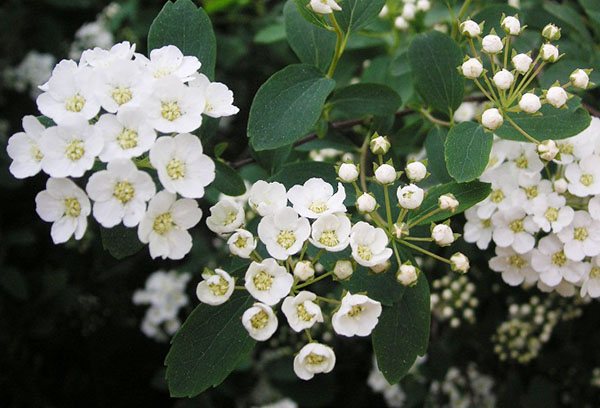

Early flowering (spring) species of meadowsweet
Snow-white flowers with a yellow core and incredibly long stamens are a feature inherent in early flowering spireas. Dense corymbose or umbrella-shaped inflorescences densely stick around thin shoots, forcing them to bow down to the ground. The appearance of "snow" on the branches occurs in late spring or early summer.Flower buds are laid on last year's shoots, located along the entire length of the branches. May "snow storm" lasts only 2-3 weeks, fills the garden with fragrance, attracting a lot of pollinators.
The following spring types of spirea are most often found in culture:
- Wangutta;
- Nippon;
- Thunberg;
- Oak-leaved;
- Gray;
- Arguta;
- Average;
- Gorodchaty.
They differ slightly in height, shape of crown and leaves, size of flowers, inflorescences. Some representatives have a snow-white color, others have a cream color. The Nippon Spirea dresses up in a crimson dress in the fall, and Wangutta burns with an orange flame.
The listed varieties are photophilous, but tolerate light shading. Spireas are capable of growing in Spartan conditions, but without proper pruning and periodic rejuvenation, they first grow and look sloppy, and then begin to wither away, lose their decorative effect.
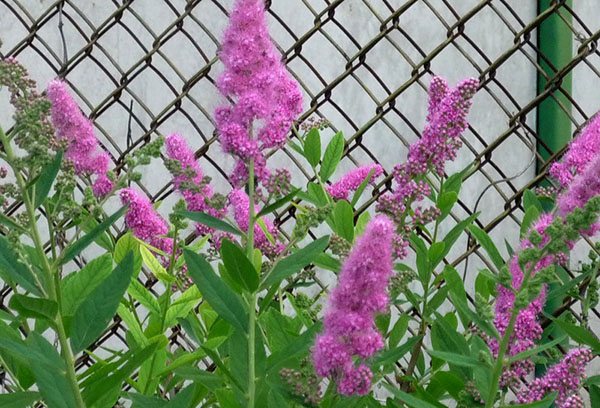

Summer blooming spireas
Representatives of this group bloom throughout the summer. They are characterized by bright juicy colors of inflorescences - pink, reddish, purple. Inflorescences are formed on the growths of the current year, have the shape of panicles or large scutes.
Summer-flowering spireas include the following types:
- Birch-leaved;
- Billard;
- Felt;
- Willow;
- Japanese;
- Dwarf;
- Boomald;
- Douglas;
- Densely flowered.
Like their spring sisters, summer-flowering spireas are unpretentious, light-loving, and can steadily tolerate gas pollution. The listed cultures will perfectly fit into the design of any garden, decorate a rabatka, mixborder. Gardeners are especially attracted by Japanese spirea, on the basis of which a lot of beautiful varieties and decorative variegated forms are obtained. Cultivars of the Japanese meadowsweet are easy to shape and are used to create garden sculptures.
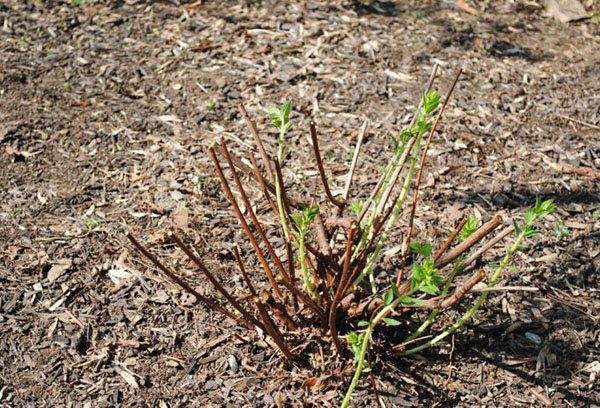

Frost-resistant varieties of spirea
As a rule, all cultivated spirea varieties are considered frost-resistant. Most of them, especially white flowering ones, are able to tolerate frosts down to -30 ° C, and some even up to -50 ° C without loss. But for this, it is necessary that with the first drop in temperature beyond zero, heavy snow falls, carefully covers the bushes, hiding even the tender shoots of the current year, and melts only in the spring. In fact, the weather rarely pampers summer residents so much, so they worry about their beautiful spirea bushes.


In April-May, drooping shoots of gray spirea are covered with snow-white flowers. Its bushes grow more than 2 m in height and width, and flowering lasts 4-5 weeks. Grefstein is a Norwegian variety with medium-sized grayish-green leaves. Probably, not least due to its frost resistance, it has become the most popular in our country.
Even earlier, spirea arguta or sharp-toothed blooms. Her leaves are bright green, sharp, and lush inflorescences, as if covering the entire bush with foam, consist of very small white flowers. The bush also grows wide and tall, up to 2 m.
Dwarf bushes of birch spirea, barely growing to 100 cm, begin to bloom in June. You can often find the Thor Gold variety with golden foliage.
In May-June, large spreading bushes of Nipponskaya spirea bloom. Its long, erect shoots only slightly incline to the ground, covered with lush white inflorescences. She is not afraid of severe frosts.
Varieties of lettuce plants are native to Korea, they also delight with white flowers, and in autumn the leaves turn orange-red. Adult plants are considered indifferent to cold weather, but young ones require shelter. Bright foliage, in addition to charming flowers at the beginning of summer, surprise Thunberg spirea and many varieties of Japanese.

